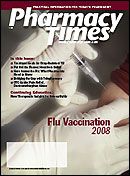Publication
Article
Pharmacy Times
Case Studies
Author(s):
Dr. Coleman is an assistant professor of pharmacy practice and director of the pharmacoeconomics and outcomes studies group at the University of Connecticut School of Pharmacy.
Gout

GA is a 52-year-old man who limps into your pharmacy and hands the pharmacist aprescription for probenecid. GA has a past medical history significant for gout and aheart attack 3 years ago and takes metoprolol, atorvastatin, and aspirin. While enteringthe patient's insurance information into the computer, the pharmacist strikes up aconversation with GA about what he did last weekend. GA tells the pharmacist that hethrew a big 40th birthday party for his wife and that he "had a few too many drinks."He then tells the pharmacist that the next day his gout flared up, resulting in a painfullyinflamed big toe. At just that moment, the pharmacist realizes that the probenecidprescription is a few months old. Upon further questioning, GA admits to the pharmacistthat this probenecid prescription was given to him along with a prescriptionfor colchicine by his physician 2 months ago. He filled the colchicine prescription atthat time and used it until his gouty attack subsided, but did not have the probenecidprescription filled. He thought he would save himself a trip to the physician and justtake the probenecid to treat this attack.
Should the pharmacist fill this prescription?
Ringworm Infection

RW is a 32-year-old woman who comes to the pharmacy counter to ask the pharmacistfor his advice. She tells the pharmacist that she has a ringworm (tinea) infectionand wants to purchase a suitable OTC, topical antifungal agent to treat it. RW is otherwisehealthy and takes no other prescription or OTC medications.
How should the pharmacist respond?
ANSWERS
Gout
Uric acid is typically excreted in the urine, but if blood uric acid levels become too high, it can be deposited in joints (most commonly the big toe), causing painand inflammation. Probenecid increases the excretion of uric acid into the urine, preventing gouty attacks, but cannot be used to treat an ongoing attack. Furthermore, aspirininterferes with probenecid's ability to increase uric acid excretion, decreasing its efficacy. The pharmacist should instruct GA to see his physician to get another prescription forcolchicine with instructions to take 0.6 to 1.2 mg every 2 hours until pain is relieved, gastrointestinal upset occurs, or a total daily dose of 8 mg is reached. Unlike probenecid, thiswill relieve the pain and inflammation of his gouty attack within hours. The pharmacist also should remind GA that too much alcohol could exacerbate his gout.
Ringworm Infection
Before the pharmacist can recommend a treatment for RW's tinea infection, he must know the location on her body where the infection has occurred. Tineainfections of the feet, thighs, buttocks, or body can be treated with the application of an OTC, topical antifungal cream for up to 4 weeks. Nail (tinea unguium) and scalp (tineacapitis) infections are more difficult to treat and typically require treatment with prescription oral agents (-azoles, griseofulvin, terbinafine). Upon questioning, RW admits to havingan infection of her toenails. Consequently, the pharmacist should tell RW that an OTC product is probably not sufficient to treat her tinea infection and should recommend thatshe see her physician to get a prescription for terbinafine (a highly lipophilic, oral antifungal drug that penetrates and accumulates in the nail bed).
Read the answers
function showAnswer() {document.getElementById("answer").style.display = 'block';document.getElementById("link").style.display = 'none';}







